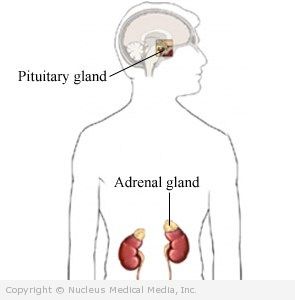Cushing’s Syndrome
(Cushing’s Disease; Hypercortisolism)
Cushing’s Syndrome – Definition
Cushing’s syndrome is a hormonal disorder. It is caused by prolonged exposure to the hormone cortisol.
Hormones are chemicals in the body. Cortisol is a common hormone. In normal doses it helps the body manage stress and infection.
Cushing’s Syndrome – Causes
Prolonged or excess exposure to cortisol as a result of:
- Long-term use of corticosteroid hormones such as cortisone or prednisone
- Tumor or abnormality of the adrenal gland, which causes the body to produce excess cortisol
- Tumor or abnormality of the pituitary gland, which causes the body to produce excess cortisol (in the case of a pituitary tumor, it is called Cushing’s disease)
- Rarely, tumors of the lungs, thyroid, kidney, pancreas, or thymus gland produce hormones that trigger the syndrome
Cushing’s Syndrome – Risk Factors
Factors that increase your risk of Cushing’s syndrome include:
- Chronic use of corticosteroid medicines
- Age: 20-50 years
- Sex: female (much more common in women)
Cushing’s Syndrome – Symptoms
Although symptoms may vary, common symptoms of Cushing’s syndrome are:
- Weight gain of the upper body and trunk
- Face shaped like a moon
- Skin changes:
- Darkening of the skin
- Purple stretch marks
- Easy bruising
- Excess hair growth or acne in women
- Menstrual disorders, especially infrequent or absent periods
- Diminished fertility and libido
- High blood pressure
- Water retention or swelling
- High blood sugar or diabetes
- Tiredness or fatigue
- Personality changes or mood swings
- Muscle weakness
- Osteoporosis or brittle bones
- Skeletal delayed growth in children
- Increased thirst
- Frequent urination
- Psychosis
- Low back pain
Cushing’s Syndrome – Diagnosis
The doctor will ask about your symptoms and medical history. A physical exam will be done.
Tests for Cortisol Levels
- 24-hour urinary free cortisol level — Urine is collected for 24 hours and tested.
- Late-evening cortisol saliva/blood level—Saliva or blood is collected around 11 pm and tested.
- Dexamethasone suppression test—A synthetic cortisol called dexamethasone is taken by mouth; blood and urine samples may be taken overnight or over several days.
Tests to Determine Cause of Cushing’s Syndrome
- CRH stimulation test
- ACTH level
- High-dose dexamethasone suppression test
X-rays and Scans
These tests may show whether there is a tumor in the pituitary or adrenal glands or another area of the body. Common imaging tools include:
- MRI scan — a test that uses magnetic waves to make pictures of the inside of the body
- CT scan — a type of x-ray that uses a computer to make pictures of structures inside the body
- Chest x-ray — which may detect tumors in the lungs
Cushing’s Syndrome – Treatment
Treatment of Cushing’s syndrome depends on the cause.
Treatments include:
- Surgical removal of tumor (most common treatment option)
- Surgical removal of part, all, or both adrenal glands
- Radiation for some persistent tumors
- Gradual withdrawal of cortisone-type drugs under close medical supervision
- Drugs that decrease cortisol production or block the functioning of other adrenal products
Cushing’s Syndrome – Prevention
Work with your doctor to keep use of corticosteroid drugs to a minimum.

